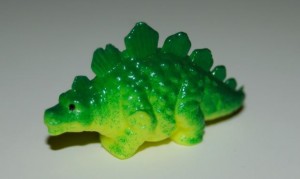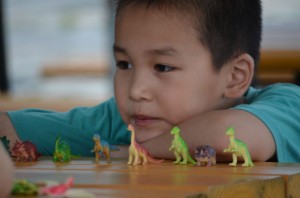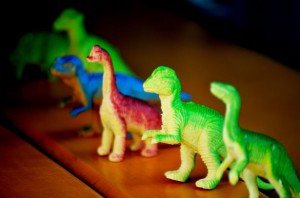Dinosaurs are great for all kinds of math activities in Dinovember and anytime of the year. Dinosaurs know lots about numbers, think of how long ago they lived!
Have you heard of Dinovember? It started with parents Refe and Susan Tuma who wanted to keep the magic of childhood alive for their kids with a little mystery and wonder: the dinosaur toys came alive at night and had adventures. For a play-of-the-day, how about some math adventures with dinosaurs?
 Plastic dinosaurs are inexpensive and come in a variety of colors and sizes. Just noticing how some are big and some are little is a math concept. It sounds simple but it’s pretty tricky because objects are big or little only in comparison to each other. Older preschoolers may want to line up their dinosaurs according to size. This dinosaur has plates that start big and go smaller down the tail.
Plastic dinosaurs are inexpensive and come in a variety of colors and sizes. Just noticing how some are big and some are little is a math concept. It sounds simple but it’s pretty tricky because objects are big or little only in comparison to each other. Older preschoolers may want to line up their dinosaurs according to size. This dinosaur has plates that start big and go smaller down the tail.
 Kids can use dinosaurs to count. They may not use the names of numbers accurately but counting takes countless practice. Children are also learning how many items go with each number. One dinosaur in each hand makes 2. Kids need to develop the idea of ‘twoness’ so that they can look at a few toys and tell by looking if it is two. They develop a sense for other numbers too.
Kids can use dinosaurs to count. They may not use the names of numbers accurately but counting takes countless practice. Children are also learning how many items go with each number. One dinosaur in each hand makes 2. Kids need to develop the idea of ‘twoness’ so that they can look at a few toys and tell by looking if it is two. They develop a sense for other numbers too.
 Dinosaurs can be arranged in patterns, such as blue and green, blue and green. Or big and small, big and small. This pattern is more complicated: 2 greens-red-blue, 2 greens, etc. Patterning is a complex thinking strategy that brains use to cope with large amounts of information. Patterns can reduce the information into chunks that are easier to deal with and remember.
Dinosaurs can be arranged in patterns, such as blue and green, blue and green. Or big and small, big and small. This pattern is more complicated: 2 greens-red-blue, 2 greens, etc. Patterning is a complex thinking strategy that brains use to cope with large amounts of information. Patterns can reduce the information into chunks that are easier to deal with and remember.
Another skill is one-to-one matching, such as putting one dinosaur in one egg, or having one dinosaur hatch from an egg. As children count, they are figuring out that each number means one more. As they count out more and more things, the numbers are also increasing. Some numbers are high or low, depending on how many items. Matching one item to another item helps develop the idea that one number goes to one item.
Number sense is something that children develop. Play experiences with numbers also promote a positive attitude about math. What other math play activities can kids do with dinosaurs?
